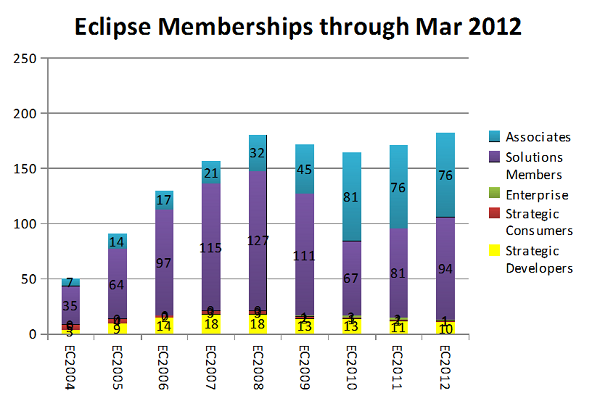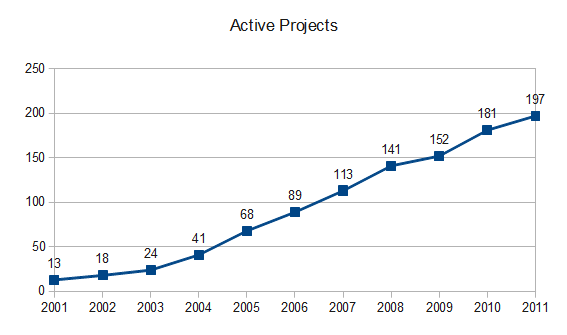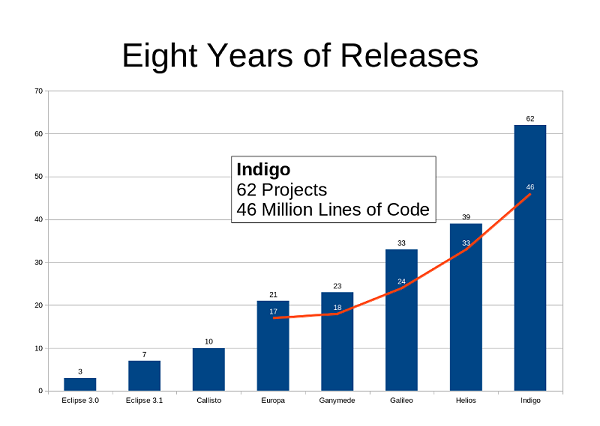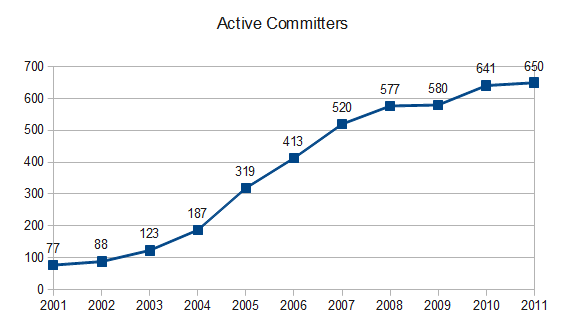2012 Annual Community Report
Published June 2012
Welcome to the first annual Eclipse Foundation Community Report. When our community last revised its Bylaws in August 2011, one of the changes was the replacement of the annual Roadmap document with an Annual Community Report. This is the first such report, and as such it is a bit of an experiment. Comments and feedback on the style and content would be appreciated at emo@eclipse.org.
Other than the financial information, this report will cover the period April 1, 2011 to March 31, 2012.
Who We Are
Our Bylaws define the Eclipse Foundation in this way:
The Eclipse technology is a vendor-neutral, open development platform supplying frameworks and exemplary, extensible tools (the "Eclipse Platform"). Eclipse Platform tools are exemplary in that they verify the utility of the Eclipse frameworks, illustrate the appropriate use of those frameworks, and support the development and maintenance of the Eclipse Platform itself; Eclipse Platform tools are extensible in that their functionality is accessible via documented programmatic interfaces. The purpose of Eclipse Foundation Inc., (the "Eclipse Foundation"), is to advance the creation, evolution, promotion, and support of the Eclipse Platform and to cultivate both an open source community and an ecosystem of complementary products, capabilities, and services.
This makes the Eclipse community a unique open source community. Not only are we interested in building open source code, we are equally committed to creating a commercially successful ecosystem around that code. This combination of interests has been a key part of Eclipse's success in the software industry.
Strategy
The following are the strategic goals of the Eclipse Foundation for 2012, as set by the Board of Directors.
- Establish and maintain Eclipse as a leading provider of open source tools and runtime technologies. The goal of Eclipse is to define for the industry a development platform that is freely licensed, open source and provides support for the full breadth of the application lifecycle, in many disparate problem domains, and across the development and deployment platforms of choice, including both desktop and the web. At least since 2004, Eclipse projects have been shipping innovative runtime technologies such as Equinox and the Rich Client Platform. The last several years have seen steady growth in runtime technologies at Eclipse. At the same time, there has been rapid growth in interest in OSGi, which is the standard upon which the Eclipse plug-in model is based. Moving forward, we expect to see rapid growth in both the projects building and the adoption of Eclipse runtime technologies.
- Create value for all its membership classes. The Eclipse
Foundation serves many members whose primary interest is leveraging
Eclipse technologies in commercial offerings such as products and
services. The Eclipse Foundation will focus its energies to ensure
that commercial opportunity exists within the Eclipse ecosystem.
Look for continuous improvements to Eclipse Marketplace, and for
other initiatives that benefit members.
Committers are also members of the Eclipse Foundation and are in many ways its backbone. The Eclipse Foundation and its staff will continue to look for opportunities to improve services to its project community throughout the year. Look for enhancements to our web, download, code management, build and other key components of project infrastructure in 2012. - Foster growth of the ecosystem, particularly in verticals. The creation of a large community of commercial and open source organizations that rely on and/or complement Eclipse technology has been a major factor in the success of Eclipse. Each time Eclipse technology is used in the development of a product, service or application the Eclipse community is strengthened. Our goal in 2012 is to focus our attention on the creation of industry working groups and new Eclipse projects that focus on particular industry segments such as mobile, automotive, insurance, and finance.
- Run a good ship. This Eclipse Foundation employs staff and represents thousands of stakeholders. It is important that the Foundation be a well run organization internally and externally.
- Continue to grow a diversified revenue model. Reliance on a single source of revenue to fund the Foundation puts us at greater risk of being negatively impacted by industry specific business cycles. It is a goal of the Eclipse Foundation to ensure revenue sources from multiple types of organizations, and seek other sources such as events and sponsorships.
Some Key Decisions
Over the past year, the Board has made a number of strategic decisions that will impact how Eclipse evolves in the future. A brief summary of these is listed below. More details can be found in the minutes of the Board, found on our website.
- Definition of an Eclipse Project: The definition of what projects will be accepted by the Eclipse community has evolved over the years. In 2011, the Board instructed the Executive Director to approve open source software projects at Eclipse that meet the following the criteria:
- The project will conform to the Eclipse Development Process
- The project will conform to the Eclipse Intellectual Property Policies and its related procedures
- The project will be licensed under the Eclipse Public License unless otherwise and unanimously approved by the Board.
- Industry Working Groups: The Eclipse Foundation believes that there will be an increasing number of enterprises participating in open source in the coming years. The Eclipse Foundation has created the concept of industry working groups (IWGs) in order to facilitate their participation at Eclipse. In June 2011, the Eclipse Board passed a number of important resolutions to facilitate these groups, including:
- the creation of a private, members-only IT infrastructure for the exclusive use of participating members of IWGs, hosted and supported by the Eclipse Foundation;
- IWGs may, in certain cases, create software binary releases made available only to their participating members, made available via that private IT infrastructure; and
- with the approval of the Board, IWGs may be allowed greater flexibility in their allowed licenses, provided that the IWG's projects must be clearly identified as separate and distinct from Eclipse Foundation projects, hosted on a web property other than eclipse.org, and not using the org.eclipse namespace. For example, the Polarsys IWG focused primarily on aerospace will be allowed to host projects under the LGPL.
- Common Build Infrastructure: The Board authorized the EMO to create and host a common build infrastructure (CBI) for the use of all Eclipse projects. Historically, each Eclipse project was responsible for creating and maintaining its own build and build infrastructure. In the future, we expect that the CBI will be a key service provided by the EMO for the Eclipse project community. The EMO has been actively working on building the CBI using Maven, Tycho, and Hudson technologies, and expects many projects will migrate to this service during 2012.
There is no requirement that Eclipse projects must utilize the Java language or OSGi modularity (plug-in) model.
Membership
The Foundation finished 2011 with a total of 175 members. By the end of March 2012, that number had increased to 181. A total of 32 companies joined as new members of the Foundation in 2011 and Q1 2012. These companies include: Cloudsoft, Inspire, Totvs, eXXcellent Solutions, Open APC Foundation, Intuit, GitHub, Juniper, Chronon, Proxiad, Verit, Sungard, Tech Unverisity Darmstadt, Jaspersoft, CloudBees, Appcelerator, Univiersity of Milano, PostFinance, Airbus, Corisecio, Fosslc e.V., Industrial TSI, Monta Vista, Suprematic, WedRatio, Antelink, Validas, Micromata, Kompetenzzentrum, SMB, Brox and Axeda.

Member Value
The recruitment of new members has been greatly assisted by the strategy of creating industry working groups (IWG). As participation in IWGs grows, our membership has grown and diversified into different industries such as automotive, machine-to-machine communications, and aerospace.
Automotive: The Automotive Industry Working Group was created to define and implement a standard platform for the software development tools used in the automotive industry. German car maker BMW Group, the automotive suppliers Robert Bosch GmbH and Continental AG, and the Eclipse Strategic Member itemis AG from Lünen, Germany were founding members of the initiative.
Machine-to-Machine (M2M): The M2M Industry Working Group was created to define and implement an open standard platform for the software development tools used in developing machine-to-machine (M2M) communications applications. Sierra Wireless, IBM and Eurotech are the founding members of the M2M IWG.
Polarsys (aerospace): The goal of Polarsys is to build and maintain an open source tools chain that is used by organizations building safety-critical and software intensive embedded systems. Industries such as aerospace, defense, transportation, telecommunications, energy and healthcare require development tool chains with a number of specific requirements, including very long term support and maintenance requirements. The initial Polarsys members are Airbus, Astrium Satellites, Ericsson, Intecs, Itemis, Obeo, Soyatec, Thales. Interested parties in Polarsys which should soon join the IWG include ATOS, CEA, CS (Communication & Systemes), IRIT (Institut de recherche en informatique de Toulouse), Inria, Katholieke Universiteit Leuven, Universidad Politecnica de Valencia, Tecnalia.
Conferences and Events
No description of the Eclipse Foundation's activities can fail to mention our community's successful conferences. EclipseCon and EclipseCon Europe were both enormously successful. Both events were beyond our expectations with regard to participants, sponsors, and positive attendee feedback. As but one sample metric, over 84% of EclipseCon 2012 attendees rated the conference as either “Excellent” or “Very Good”. The EclipseCon conferences, Eclipse Days and DemoCamps are the primary events that the Eclipse Foundation supports to help foster the strong personal relationships in the community that only face-to-face contact can create. We highly encourage all Eclipse community participants to participate in these events.
Financials
The Eclipse Foundation's fiscal year end is December 31. Our auditors are the firm Deloitte & Touche, LLP. The Eclipse Foundation is incorporated in the State of Delaware, USA as a 501(c)6 not-for-profit. Its headquarters is located in Ottawa, Canada.
2011 was a solid year financially for the Eclipse Foundation. Despite losing Nokia as a major funder, and Strategic Developer Member, overall revenue was up slightly over 2010. Our website advertising program, initiated in 2011, was an important part of that success. Despite originally budgeting a $300K loss, the Eclipse Foundation made a small surplus for the year, which was contributed to its cash reserves. The organization continues to be on a solid financial footing.
| In US $ millions | vs. Budget | vs. Actual | ||||
| Budget | Actual | 2010 | 2011 | |||
| Revenue | 4.1 | 4.1 | 4.0 | 4.1 | ||
| Expenses | 4.4 | 4.0 | 4.1 | 4.0 | ||
|
Net Income |
-0.3 |
0.1 |
-0.1 |
0.1 |
||
Intellectual Property Management
During the time period spanning April 1, 2011 to March 31, 2012, the Eclipse Foundation received 1325 requests for code review and completed review of 1337 requests. With the January 2012 deadline to submit IP requirements for Juno came a high volume of submissions. As a result, The backlog of IP review requirements reached an all time high this past January that is likely to result in delays for the committer community for several months to come. The overall backlog of committer requests increased rom 79 on April 1, 2011 to 273 on March 31, 2012. As of the time of this writing all code requested for Juno has been reviewed for the community and significant progress has been made in Q1 2012 such that the backlog currently sits at 114.
Approximately 60% of the backlog consists of requirements from Incubating Projects that will benefit from parallel IP. To address the backlog, improve wait times for the community, and prepare the Foundation to deal effectively with IP contributions from new projects and Industry Working Groups, the Foundation intends to hire an additional IP Analyst in 2012.
Innovation
The past year has seen an enormous amount of innovation within the Eclipse community. A few key projects and technology areas are listed below, with comments on both their recent past, and their future direction. This is certainly not intended to be exhaustive, but will hopefully provide some of the highlights of the exciting technologies being built by the Eclipse community.

Indigo Simultaneous Release
In June, 2011 the Eclipse community shipped Indigo, its sixth annual simultaneous release. Including previous releases of the Eclipse Platform, this was the eighth release that was shipped on time to the day. Sixty-two projects participated in the Indigo simultaneous release, comprising 46 million lines of code. Over 250,000 downloads were recorded for Indigo in its first three days. This predictable release schedule has been a key part of Eclipse's success over the years, and is an important part of the success of the Eclipse ecosystem.

Highlights of the Indigo release include the addition of world-class GUI building support from the WindowBuilder project, Maven integration from the m2e project, and automated functional GUI testing for Java and HTML applications from the Jubula project.
The complete list of new projects that joined the release train for the first time include
- Agent Modeling Platform
- Eclipse Generation Factories (EGF)
- Eclipse Gyrex Project
- Eclipse Runtime Packaging Project
- Eclipse Scout
- EMF Facet
- Graphiti
- Jubula Functional Testing Tool
- Maven Integration
- Object Teams
- WindowBuilder
Eclipse 4.x
2011 saw another release of the Eclipse 4 stream – Eclipse 4.1. Version 4 of the Eclipse Platform has had two releases since graduating from the e4 incubator, but was still treated as secondary to the 3.x platform generation. In the 2012 Juno release we will take the final steps to make version 4.2 the primary platform for enterprise level adoption. This work includes refactoring and cleanup of the workbench compatibility code, implementing Intro support, improving performance, addressing globalization and accessibility bugs, and regularly running the full suite of Eclipse SDK regression tests against Platform version 4.
The major goals of the 4.x release stream of the Eclipse platform include:
- Making it easier to write plug-ins (e.g. making Eclipse an even better Rich Client Platform)
- Allowing better control over the look of Eclipse based products
- Increasing diversity of contributors to the platform
- Maintaining backward compatibility for API-clean clients
Eclipse 4.2 shipping as the platform for the Eclipse Juno simultaneous release marks the first major revision of the Eclipse platform since 3.0 in 2004. This has been a major undertaking by the Eclipse platform team, one that will well situate Eclipse for future success.
Orion
Eclipse tools have historically had a very strong correlation with the Java language. However, with the rapid growth of Rich Internet Application languages and technologies such as JavaScript and Ajax, the Eclipse community must support the requirements of these developers as well. Orion's objective is to create a browser-based open tool integration platform that is entirely focused on developing for the web, in the web. Tools are written in JavaScript and run in the browser. Unlike other attempts at creating browser-based development tools, this is not an IDE running in a single tab. Links work and can be shared. You can open a file in a new tab. Great care has been taken to provide a web experience for development.
The Orion project's focus is creating components, services, and libraries for building web-based development tools. This includes browser client infrastructure built using widely adopted web technologies such as HTML, JavaScript, and CSS. Also included is server-side infrastructure needed by such development tools. This includes infrastructure supporting file management, search, user management, preferences, generic source control, compare, file history, editors, and user interface widgets and controls required to build development tools.
Orion launched in early 2011 and continue to receive emphasis and promotion throughout the year. Orion is not targeted at the classic Eclipse developer, but is instead targeted at Web and RIA developers. This new development model and target audience will even further diversify and grow our community in new and exciting directions.
Orion is expected to ship its 1.0 release in Q4 2012.
Modeling
The increasing popularity of modeling and model-driven development continues to be an important driver for the growth of Eclipse. The modeling ecosystem is active and diverse with commiters from more than 30 different companies. New projects are created with regularity and are inherently integrated by virtue of their reuse of EMF's core APIs.
- In 2012, modeling extends its community by addressing the need of a broad range of domains.
- DSLs for programming languages using Xtext's extensible expression language are exploited by Xcore, a textual syntax for EMF's Ecore and by Xtend, an concise JVM-based language. Both support rich textual editors reminiscent of JDT's Java editor.
- A DSL for business modeling with GMF 3.0 and EEF 1.1 that supports the creation of custom graphical and forms-based editors.
- Support OMG standards, including Acceleo 3.3 for code generation, OCL 4.0 with more efficient API and tooling, and support for the UML 2.4 and BPMN 2 specifications.
- Massively scalable deployment with CDO for collaborative and distributed repositories as well as EGF to manage the assembly of software factories.
With the launch of Juno, EMF will be in heart of Eclipse 4.2 SDK's workbench model. This is a great opportunity for end users to discover the various interesting modeling innovations.
Committer and Project Community

The EMO is committed to providing steadily improving services to the Eclipse Committers and the projects they work on. Here is a sampling of some infrastructure metrics, plus some improvements we've put into place over the past year.
- In 2011, the EMO announced that CVS will be deprecated as a source code management system at Eclipse, and that git will become the new standard SCM for the community. All projects using CVS will be required to migrate to git by December 21, 2012.
- The Gerrit Code review system was deployed at Eclipse.org for use by Eclipse projects. By the end of March 2012, 14 Eclipse projects were making use of Gerrit.
- Overall service availability for 2011 was 99.96%. Three hardware failures in May caused unexpected downtime.
- We've entered 2012 with storage, database, and network hardware that is mostly two years old or newer, a significant improvement as much of our server infrastructure was quite old going into 2011. For example, a pair of new NFS file servers have been deployed. New servers provide additional disk space and ensure adequate performance to allow for future growth.
- The EMO rolled an open source PBX called Asterisk to provide a community-wide conference call facility. This facility provides phone numbers that can be accessed using a regular or mobile phones in Canada, the US, the UK, France, and Germany. Additionally, those with voice over IP (VoIP) capability can participate in conference calls using VoIP protocols. It is expected this facility will provide the same or better quality conference calls as our previous facility at significantly lower cost.
- We simplified Eclipse.org authentication thanks to the consolidation of our Committer accounts and Bugzilla accounts and the introduction of LDAP
- We upgraded to Bugzilla to 4.0
- We improved server throughput to Europe, improving response times and download times for the Eclipse community in Europe.
- Improved consistency: We implemented configuration/data-driven project web presence, and direct linkage among releases, reviews, and plans. Information – including basic project metadata, project plans, and release review information – is captured and retained in a consistent (and easily leveraged) data-based format (rather than in multiple documents in arbitrary formats).
- All-in-one-place: Committers are able to edit information in place on the project information pages. Text/information in one place with links in another is eliminated wherever possible. Comments and discussion related to reviews, elections, etc. are connected directly to the item being discussed.
- Get started faster: By default, projects are provided with a data-driven website that includes consistent links to project releases, reviews, downloads, etc. Projects can opt to override the default and provide their own customized web presence.Setting up a project presence is a matter of configuration, not PHP programming against proprietary APIs.
Project Management Infrastructure
In addition to the above, in 2011 the Eclipse Foundation began a new effort to replace the existing project management infrastructure – which includes the Developer Portal – with a new unified infrastructure with the intent of making project management activities more consistent and generally easier for all involved. Themes of this effort include:
